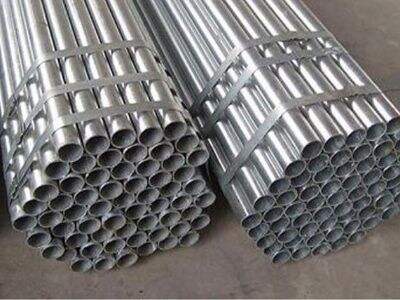Ular muhim hisoblanadi va sanoatda turli sektorlarda ishlatiladi. Neft, qaz, qurilish va kanalizatsiya kabi sanoatlar. Barcha ulardagi sifatli va davom etadigan trubalar muhim. Ug勒karbon trubalar farqli darajalarda keladi. Har bir darajada trubaning xususiyatlari bo'yicha turli materiallardan tuzilgan va ularning turli holatlardagi performansiga ta'sir qiladi. Demak, bu darajalar orasidagi farqlarni bilish va shu farqlar nimaga ta'sir qilishi lozim.
Kategoriya: Karbon metallik trubalar
Asosan, karbon metallik trubalar haqida gapirganda uchta daraja mavjud.
A darajasi: Eng pastki daraja Uglerod po'lat truba. Uda eng ko'pi 0.25% karbondan iborat. Bu esa oson holda murakkab emas, lekin ba'zi vazifalar uchun yaxshi ishlaydi. A darajasidagi trubalar past bosimli takliflarda, masalan suv ta'minoti tizimlari va kanalizatsiya tizimlari uchun ishlatiladi. Ular suvni transport qilish uchun idealdir, chunki bosim juda yetarli emas.
B darajasi: A darajasidan bir oz oshich carboni mavjud, maksimal carbon miqdori 0.30%. Ushbu qismini carbon orqali kuchli bo'lib, baland kuchga ega. Ushbu turdagi trubalar eng ko'p o'rta bosimli vazifalarda ishlatiladi, masalan, neft va do'konni bitta joydan boshqa joyga transport qilish uchun. Ular Grade A trubalardan kuchli bo'lganligi sababli bir oz oshgan bosimni yuqorilaq sabyotida saqlay oladi.
C darajasi: Uchtaidan eng ko'p carbon bilan, eng katta 0.35% carbon. C darajasi trubalari extremal kuchga ega va baland bosimli vazifalar uchun ishlatiladi. Ular umuman buxar va tabiiy do'konda bor pipeline-larda joylashgan. Ushbu trubalar baland bosim va temperaturadan sababli juda kuchli bo'lishi kerak.
Sifatning performansga ta'siri
Haqiqiy hayotda oqimoqda carbon tellerining performansi sifatiga bog'liq ravishda o'zgarishi mumkin. Yuqori sifatli trubalar umumiy ravishda kuchli va davom etadigan. Ular sharoitlarni yengillashtirishda ham yaxshi natija beradi.
Qanday qilib bor yasaladi, uning sifati haqida bir qancha muhim aspektlardan biridir. Sifat shuningdek, eng yaxshi material yaratish jarayonidan o'tkazilganlarini aniqlash uchun ham muhim; albatta, sifatli bormalar sizga bir necha yildan keyin kamroq muammolar tashkil qiladi. Ushbu yasash jarayoniga e'tibor bering, chunki bu borning kuchiga va davomiyligiga ta'sir qilishi mumkin. a53 ug'irtma toksi shuningdek, sifatli bormalar sizga bir necha yildan keyin kamroq muammolar tashkil qiladi. Ushbu yasash jarayoniga e'tibor bering, chunki bu borning kuchiga va davomiyligiga ta'sir qilishi mumkin.
Ug'irtma toksi bordaning sifati bir nechta turli faktordan bog'liq bo'lishi mumkin: bor divarlarning qalinligi, bor diametri yoki kengligi va ishlatiladigan to'qiq (yoki ichki qopqo) turi. Ushbu to'qiqqlar bormalarni rustdan va eroshiyadan himoyalaydi, bu ularni ziyoratsiz qilishi mumkin.
Ug'irtma toksi bormalarning darajalari orasida qanday farqlar mavjud?
Ug'irtma toksi bormalarning turli darajalari orasidagi asl farqlarni tushunish uchun ularning tarkibiga va xususiyatlarga qarashingiz mumkin.
Bular qatorlar orasidagi asosiy farqlar biri metallik tug'ilgan yiligidagi ugatning miqdori. Umuman olganda, ugat miqdori borliq ortib boradiganida, borliq va ung'lik ham ortadi. Bu esa ugat miqdori ko'p bo'lgan borliqlar juda quvvatli ekanligini anglatadi. Ammo ko'p ugat borliqni to'siqlovchi qilib berishi mumkin. Demak, bazi shartlarda u osonroq chiziq yoki buzilishi mumkin.
Qatorlar orasidagi farq - Tug'ilgan yiligidagi boshqa elementlar Masalan, ba'zi qatorlar oson miqdordagi manganyesdan iborat. Bu borliqni quvvatli va mosxona qilib beradi, bu esa qurilish manzillarida foydali bo'lishi mumkin. Shu tarkibiy farqlar berilgan manzil uchun mos borliq tanlashda muhim hisoblanadi.
Qanday carbon steel borliq tanlash kerak?
Loyihangiz uchun carbon steel borliq qidirganda, istagan performans xususiyatlaringizni hisobga olish muhim. Bunday qaror qabul qilishda yordam berish uchun hisobga olinishi kerak bo'lgan bir necha omil mavjud:
Shunday qilib, siz kuchli va iloji boricha oson turib turadigan borningiz kerak, uni loyihangizning talablari oldidan utqazishi va tezda to'qilmasligi yoki xavfsiz bo'lishi uchun.
Charg'alarga muqarriq: Charg'alarga qarshi muqavim etadigan bormalar uzun davomli ishlatish va kamroq saqlash talabini ta'minlaydi.
Yuqori harorat va bosimlarni boshqarish imkoniyati: Ishtirok etilayotgan vazifadan qaroringizga qarab, shartlarga muvofiqlik etgan borma talab bo'ladi.
Qulay o'rnatish va saqlash: Ba'zi qora karbon tiltdan iborat kanal ularni o'rnatish va saqlash osonroq. Bu oxirida vaqt va pulni saqlashga yordam beradi.
Bu aspektlar sizga talablariga mos carbon metallidan bormani tanlashda yordam beradi. Bunday holatda, agar siz juda baland bosim va haroratni hisobga olgan holda ishlatishingiz mumkin bo'lgan borma kerak bo'lsa, har doim C darajasiga ishonishingiz mumkin, bu aniq tanlov sifatida xizmat qiladi. Aksincha, agar siz o'rnatish va saqlashni osonroq ko'rsatmoqchi bo'lsangiz, A darajasi siz uchun yaxshiroq bo'lishi mumkin.
Borma metallari darajalari haqida muhim ma'lumotlar
Uglerodli toksi borlar endustriyalik ishlatilishda xavfsizlik, effektivlik va umumiy kasbni oshirishga yordam beradi. Masalan, agar bor sifatiga ega bo'lmasa, ish faoliyati to'xtashiga sabab bo'lishi mumkin. Ish faoliyati to'xtaydi va ko'p pul yo'qoladi. Borning ishlashiga to'xtatishi xavfsizlik muammolarini yaratishi mumkin va hech qanday kompaniya bilan bog'liq bo'lmasligini istamoqdamiz.
Shuning uchun, uglerodli toksi bormalarining darajalarini yaxshi tushunish ularidan foydalanuvchi kompaniyalar uchun zarurdir. Yuklanadigan bino va qurilish talablari bo'yicha yuqori sifatli bormalaridan foydalanish kompaniyalarga infrastrukturani xavfsiz va ishonchli ravishda himoyalashga imkon beradi. Bunday ahamiyatli tanlovi faqat ishchi larni himoyalaydi balki turli ecologik muammolarga ham oldincha qarshi hissa tutadi.
Bu, endustriyada ishlatiladigan eng umumiy turdagi konstruktiv oqimlardan bir nechasi va Lurun barcha darajalarda yuqori sifatli uglerov odamlarini taklif qiladi. Shogirdlikdan muhrangizga qarab, biz odamlarning faqat ishlashiga, balki huddi ham qattiq endustriyal avvaliy sharoitlarda uzun muddat davom etishiga ishonch hosil qilamiz.
 EN
EN
 AR
AR
 NL
NL
 FI
FI
 FR
FR
 DE
DE
 EL
EL
 HI
HI
 IT
IT
 JA
JA
 KO
KO
 PT
PT
 RO
RO
 RU
RU
 ES
ES
 SV
SV
 TL
TL
 IW
IW
 ID
ID
 SR
SR
 UK
UK
 VI
VI
 ET
ET
 HU
HU
 MT
MT
 TH
TH
 TR
TR
 FA
FA
 AF
AF
 MS
MS
 SW
SW
 MK
MK
 KA
KA
 BN
BN
 BS
BS
 LO
LO
 MN
MN
 MY
MY
 UZ
UZ



